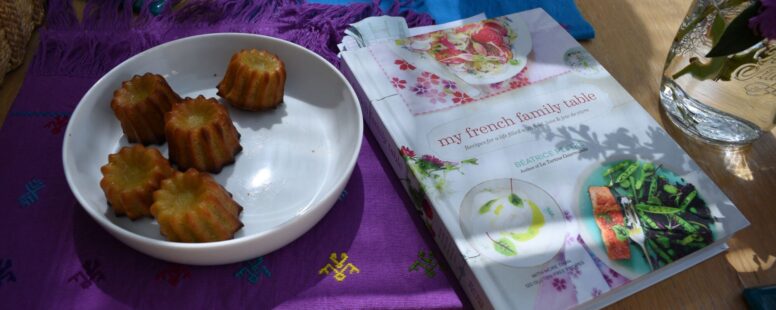Table of Contents
A guide to the language of cookbooks

Today's is a flying visit to the language of cookbooks.
It makes sense to start with technical language. An example would the beurre noisette discussed here. Another would be the specific sentence order used in recipe instructions, which I will discuss another day.
Then comes the author’s language which might or might not be a signature trait. Imagine Jamie Oliver saying ‘whack the chocolate on the countertop’, which is bound to be translated as break the chocolate, or Nigella’s supposed sexual innuendos (1). I wonder to what extent their style transfers to their cookbooks; although I did read that Oliver’s Italian translators had upped the register of his books (2), which is a bit of a shame. On the other hand, it could come out cheaper: idiomatic translations take a fair bit of imagination and time to translate. They would also be truer to his style.
Thirdly, no surprise here, the language of cookbooks is tied to marketing. I'll break this into small bites.
Starters
The messages, and the language used to relay these, might differ depending on whether prospective readers are men or women. An article in Critical Discourse Studies (3), where the relationship between language and gender in female celebrity chef cookbooks is discussed, was indeed very useful for my dissertation: my author was a female writing for an American audience and I could clearly see how she’d inspired herself in those celebrity books in some of the messages she sent out. Another article in Feminist Review (4) discussed masculinity in European cooking shows and I could see the author's point because I was familiar with many of the shows discussed, including Gordon Ramsay’s and The Hairy Bikers’.
Mains
Like pictures, the language of a cookbook plays an essential role in its sales, something not to be taken for granted. For example (5), Maori food names are used in Kiwi travel guides to make New Zealand sound exotic -not unlike the abundant French in La Tartine Gourmande, which left me with the challenge of deciding what terms to translate and what to leave in French and why. And that excludes the many terms in English and other languages, given its fusion cuisine.
Pudding
There is the relationship between the language of cookbooks and their time. As Humble (2008, p. 323) puts it, "the cookery book has been one of the key publishing success stories of this period [the last 150 years] precisely because of its ability to continually re-invent itself in line with new trends." This was proven in a food styling course imparted by Ferrandi that I attended recently where we learnt how food styling had evolved over time.
What goes for food styling goes for language: it’s about presenting the soul of the food in question but, importantly, presenting it in the most appealing fashion to the consumer of the time. So, in the mid-nineteenth century, a market was born for a a cookery book that would address the needs of the new urban professional class. One of them was Mrs Beeton's Household Management (1861) which helped the upwardly mobile middle class housewife entertain like the aristocracy. Mrs Beeton introduced them to a wide range of foreign recipes; presented them as objects of envy to flatter them; and made them feel comfortable by pretending they weren't actually doing the cooking by including a chapter for the housekeeper and another for the mistress, using 'high flown quotations' in the latter and 'saws and proverbs' in the former (ibid, p. 325).
In the 1920s, British cookbooks were expensively produced and used suggestive language to promote foreign foods, but skip to the First World War and the language changes from 'eating' to 'feeding' and nutrition becomes the key topic. The tone also changes to 'chummy' and 'cajoling' (ibid, p. 331) and promotes the government food policies. Finally, cookbooks become classless.
After the war, fantasy food reappears with Elizabeth David's A Book of Mediterranean Food, even if rationing does not leave room for it, but people need evasion. Skip to the 80s and food becomes 'piquant' 'luxurious' 'elegant' 'pretty' 'perfect' and 'rich', showing the concerns of the time. But in the 90s, after the crisis and food scares, we are back to comfort food. Adjectives like 'soothing' 'comforting' 'calming' or 'warm' are used by Slater, Lawson and Smith.
In La Tartine Gourmande (Boston, Massachusetts, 2012) (the book I partly translated for my dissertation) we find 'organic, home-made, gluten-free, wholesome, light, delicate, gourmand, irresistible, fusion cuisine. If you are interested in the history of British cuisine, see Bullock and Humble (6 & 7).
Homework
Below you'll find some cookbook extracts in the hope they’ll reflect the point about messages and, to an extent, about language. You might recognise the authors; if you don't, ask yourself:
- Is the author a man or a woman, young or older? What makes you think so?
- Are they addressing a man or a woman? A single or a married person?
- What is the message they’re trying to sell?
- Have they got a distinguishable style?
Author list
- Aran Goyoaga
- Béatrice Peltre
- Elizabeth David (1989)
- Ella Woodward
- Gordon Ramsay
- Mrs Beeton (19th century)
- Nigel Slater
- Paul Hollywood
Extracts
- A black, wet, winter’s night. The kitchen is dark save for the light from the oven. A light as sweet as treacle. In the oven is a wedge of pumpkin or a humble baked potato, a roasting cauliflower or golden roots. [...] There may be the scent of warm thyme or garlic....
- This pasta is my favourite dish to serve to girlfriends when they come over for an easy kitchen supper. It’s simple to make, totally delicious and wonderfully comforting. It’s also full of amazing green veggies, so it will give you lots of goodness.
- Feeling curious, I immediately asked her how she had made it, knowing that I would want to bake my own. “Oh, tu sais,” she said. “Je l’ai fait un peu au pif ! ». […] If you ever ask, that is often how the French cook.
- And it is bound to leave an impression in your guests, especially if you decide, as suggested, to make individual soufflés for each guest.
- This scrumptious risotto really celebrates the flavors of fall: it’s also Philip’s absolute favourite dish. Every time I make it -never frequently enough in his opinion-
- You’ll probably love this tart with its accents of marjoram, honey and lime as much as we do. It is bound to make you happy.
- Lulu, in fact, inspired the recipe, as I was brainstorming ideas for her to enjoy vegetables under a new form. She gobbled the pancake down so quickly that I was scared she was going to choke.
- This is my Saturday family dish, because Sunday is my morning for a two-and-a-half-hour run and I try to load up on carbos the day before. It’s also a good one for the kids. I tend to use the ‘disguise’ method to try to get them off sweet things.
- I love the deep, tangy flavour of this bread -it’s just fantastic with cheese and another glass of beer! You don’t have to use Spitfire, any good ale will do.
- Mascarpone is a pure, double-cream cheese made in Northern Italy, sometimes eaten with sugar and strawberries in the very same way as the French Crémets and Coeur à la crème. We have several varieties of double-cream cheese here. None has the finesse or marcarpone but there are one or two which make a most excellent sauce for pasta.
- The cauliflower is less indigestible than the cabbage; it possesses a most agreeable flavour and is sufficiently delicate to be served at the tables of the wealthy. It is a wholesome vegetable, but should be eaten moderately, as it induces flatulence.
- Homemade pasta is a breeze. I get the ragù going, and as soon as the pot is in the oven, I begin making the pasta. It doesn’t take much time at all; however, I leave it for those days when the house is quiet and I crave some solitude in the kitchen.
REFERENCES (in the order they appear in the text)
- Oppenheim, M. (2018, January 18). Nigella Lawson rebuffs suggestion her cooking shows are innuendo ridden in awkward TV interview. Retrieved from https://www.independent.co.uk/news/uk/home-news/nigella-lawson-cooking-shows-sexual-innuendo-tv-interview-australia-hamish-macdonald-channel-ten-the-a8166536.html
- Rossato, L. (2015). Le grand culinary tour: adaptation and retranslation of a gastronomic journey across languages and food cultures. The Translator, 21(3), 271-295. https://doi.org/10.1080/13556509.2015.1103096
- Matwick, K. (2017). Language and gender in female celebrity chef cookbooks: Cooking to show care for the family and for the self. Critical Discourse Studies, 14(5), 532-547. https://doi.org/10.1080/17405904.2017.1309326
- Leer, J. (2016). What's cooking, man? Masculinity in European cooking shows after The Naked Chef. Feminist Review, 114(1), 72-90. https://doi.org/10.1057/s41305-016-0012-0
- De Marco, A. (2015). Are green-lipped mussels really green?: Touring New Zealand food in translation. The Translator, 21(3), 310-326. https://doi.org/10.1080/13556509.2015.1103098
- Bullock, A. (2012). The cosmopolitan cookbook: Class, taste and foreign foods in Victorian cookery books. Food culture & Society, 15(3), 437-454. https://doi.org/10.2752/175174412X13276629245966
- Humble, N. (2002). Little Swans with Luxette and Loved Boy pudding: Changing fashions in cookery books. Women: a cultural review, 13(3), 322-338. https://doi.org/10.1080/09574040220000266441
Check out my services
© Pili Rodríguez Deus | All rights reserved.
